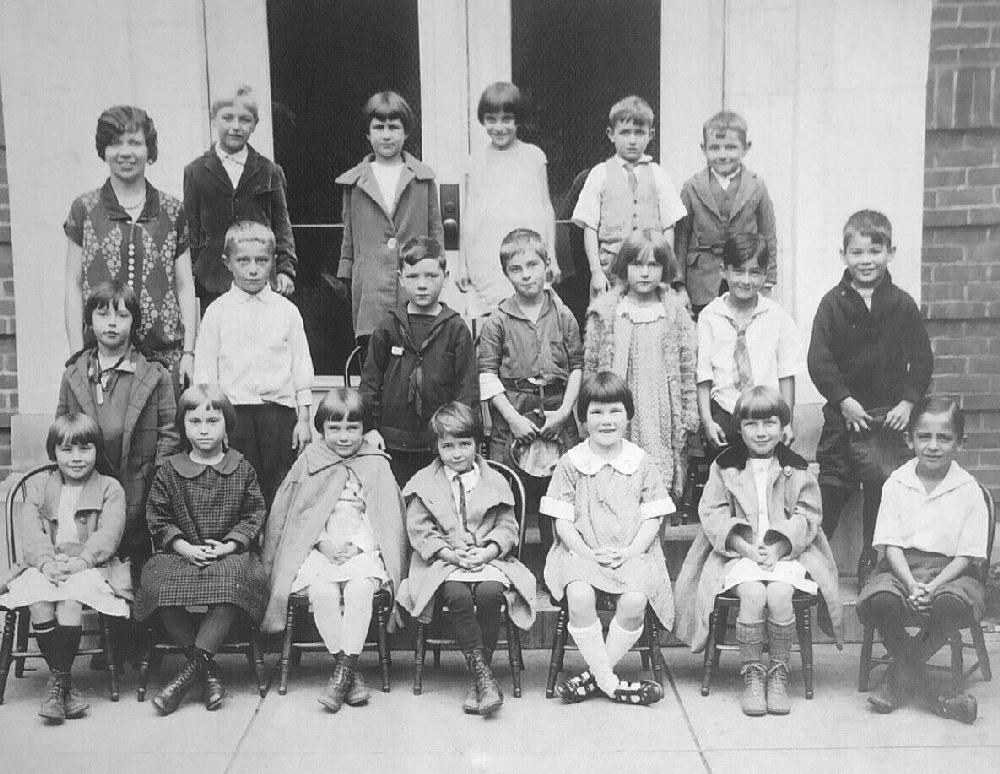
Figure 1.-- . |


|
We have not yet developed much information on girls' school wear in America. Unlike Europe, American schools were coeducational at both the primary and secondary level. We have an extensive American school section, but it does not focus on the girls. American schools from an early point adopted a coeducational approach. This was revolutionary approach to education. European education including English education was almost entirely for boys only. The exception was in Prussia which adopted public schooling, at least in small village schools (18th century). American coeducation was not the result of any early progressive thought about the benefits of educating girls. It appears to have been a mixture of religion and practicality. First, the religious imperative was created by the Reformation. The Protestants believe that people to ensure their salvation need to read the Bible. The Catholic Church saw this as dangerous, The faithful should rely on the priests for salvation. Reading the Bible of course required learning to read. This included women, not only for their own salvation, but because played a major role in teaching children to read before public education became well established. Second, practicality related to the frontier. People living in sparsely populated frontier areas did not have access to well developed schools. Schools, if they existed at all, were small with only a handful of children. It simply was impractical to have separate schools for boys and girls. Early schools had a religious association. A major purpose was religious instruction. And women played a much more important role in American churches than was the case in Europe. This means that most Colonists grew up with coeducation. It was thus not a huge leap when the frontier areas became more settled and larger schools including secondary schools began to appear. Universities were, however, slow to admit women. As public education began to be adopted in Europe, it was almost entirely single gender education with the emphasis on the boys. Coeducation is something that did not become widespread in Europe until after World War II, although the Soviets did introduce after the Revolution. Because of this dynamic, America became a leader in girls' education. We begin to see girls outnumbering boys in secondary schools years while boys dominated secondary education in Europe. There were no quotas. The girls who showed up could attend. We have a vast archive of American school images so unlike many countries, we have a lot of material to work with. We see school images from a fairly early point in America, especially beginning with the 1870s. School uniforms were not common in America. Thus school wear was essentially standard fashions at the time. After World War II, we begin to see English school fashions appearing in America--at least for the girls. These were not school set uniforms, but simply outfits that parents chose, especially jumpers (gym slips) and pleated skirts. Subsequently we see urban schools beginning to adopt voluntary uniform policies for primary children. Private schools are more likely to have uniforms, but this is a relatively small part of the school population. The school portrait was a well established tradition by the 1890s. Girls always wore dresses to school, often with pinafores into the 20th century. We have an American girls gym page. Girls continued to wear dresses during the first half of the 20th century. Some images how a few girls wearing overalls or other pants, but it was rare. The first major shift was wearing jeans. Secondary schools had resisted jeans for boys in the 1950s. This did not begin to change to any extent until the 1960s and especially the 70s when we begin to see girls wearing pants in addition to dresses. The primary schools seem to have left it up to the parents. The secondary schools resisted jeans in the 1960s, but had generally given up on fashion policing by the 70s.
We have not yet developed much information on girls' school wear in America. Unlike Europe, American schools were coeducational at both the primary and secondary level. We have an extensive American school section, but it does not focus on the girls. American schools from an early point adopted a coeducational approach. This was revolutionary approach to education. European education including English education was almost entirely for boys only. The exception was in Prussia which adopted public schooling, at least in small village schools (18th century). American coeducation was not the result of any early progressive thought about the benefits of educating girls. It appears to have been a mixture of religion and practicality. First, the religious imperative was created by the Reformation. The Protestants believe that people to ensure their salvation need to read the Bible. The Catholic Church saw this as dangerous, The faithful should rely on the priests for salvation. Reading the Bible of course required learning to read. This included women, not only for their own salvation, but because played a major role in teaching children to read before public education became well established. Second, practicality related to the frontier. People living in sparsely populated frontier areas did not have access to well developed schools. Schools, if they existed at all, were small with only a handful of children. It simply was impractical to have separate schools for boys and girls. Early schools had a religious association. A major purpose was religious instruction. And women played a much more important role in American churches than was the case in Europe. This means that most Colonists grew up with coeducation. It was thus not a huge leap when the frontier areas became more settled and larger schools including secondary schools began to appear. Universities were, however, slow to admit women. As public education began to be adopted in Europe, it was almost entirely single gender education with the emphasis on the boys. Coeducation is something that did not become widespread in Europe until after World War II, although the Soviets did introduce after the Revolution. Because of this dynamic, America became a leader in girls' education. We begin to see girls outnumbering boys in secondary schools years while boys dominated secondary education in Europe. There were no quotas involved. The girls who showed up could attend. In modern America, girls significantly outnumber boys in college. If the reverse was true it would be the subject of intense media coverage and mashing of teeth, but since it is boys that ate disadvantaged, academia and the media just ignore the problem.
We known a great deal about chronological trends. We have a vast archive of American school images so unlike many countries, we have a lot of material to work with. We see school images from a fairly early point in America, especially beginning with the 1870s. School uniforms were not common in America. Thus school wear was essentially standard fashions at the time.
A school garment associated with girls was the pinafore. It was especially common in the late 19th and early-20th century. After World War II, we begin to see English school fashions appearing in America--at least for the girls. These were not school set uniforms, but simply outfits that parents chose, especially jumpers (gym slips) and pleated skirts. Subsequently we see urban schools beginning to adopt voluntary uniform policies for primary children. Private schools are more likely to have uniforms, but this is a relatively small part of the school population. The school portrait was a well established tradition by the 1890s. Girls always wore dresses to school, often with pinafores into the 20th century. We have an American girls gym page. Girls continued to wear dresses during the first half of the 20th century. Some images how a few girls wearing overalls or other pants, but it was rare. The first major shift was wearing jeans. Secondary schools had resisted jeans for boys in the 1950s. This did not begin to change to any extent until the 1960s and especially the 70s when we begin to see girls wearing pants in addition to dresses. The primary schools seem to have left it up to the parents. The secondary schools resisted jeans in the 1960s, but had generally given up on fashion policing by the 70s. It was losing battle, especially with the girls. I taught school for a few years and concluded that many girls spent more time selecting their wardrobe than in preparing for class.
Navigate the Boys' Historical Clothing Web Site:
[Return to the Main girls' school uniform country page]
[Return to the Main girls' school uniform page]
[Return to the Main girls page]
[Return to the Main United states school page]
[Return to the Main school uniform page]
[About Us]
[Activities]
[Biographies]
[Chronology]
[Color]
[Countries]
[Difficult images] >> combine w/ photo interprtation
[Fashion]
[Families]
[Garments]
[Gender conventions]
[Hair]
[Literature]
[Photo intrpretation]
[School]
[Sisters]
[Return to the Historical Girls Clothing Home Site]
